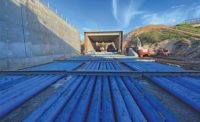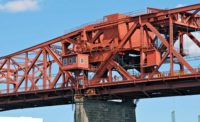"We need it to be fish-friendly and safe for the fish," Kinne says. Testing on steelhead on the Kalama River showed "really good" results, he says.
The exit is the tricky part. Bryan says it is hard to slow speeding live fish "in a controlled manner," but landing them in water serves as a great decelerator. Whooshh stops powering their movement for the last 10 ft, and the trip ends in "a nice, gentle dive."
With multiple fish in the tube— as many as 14 can travel at once in the Norwegian system—"good engineering and mathematics went into the angles, so a fish that follows isn't hitting the one that came out before," Bryan says.
On the Washougal, the salmon range from 17 lb to 30 lb, so Whooshh is optimized for that size. "The closer we size the tube to that range, the more consistent that transport is," Bryan says.
Whooshh has developed for permanent installations a multi-tube version in which, before entering the tubes, fish of differing sizes self-sort: Larger fish move past small openings until they find one that fits, and smaller fish approaching large-tube intakes are redirected into smaller ones by water cascades.
Bryan says the Washougal project already has led to a second, 200-ft-long system for use by a Washington hatchery.
"The sky is the limit on these things," Kinne says. "It seems to be very easy on the fish."





Post a comment to this article
Report Abusive Comment